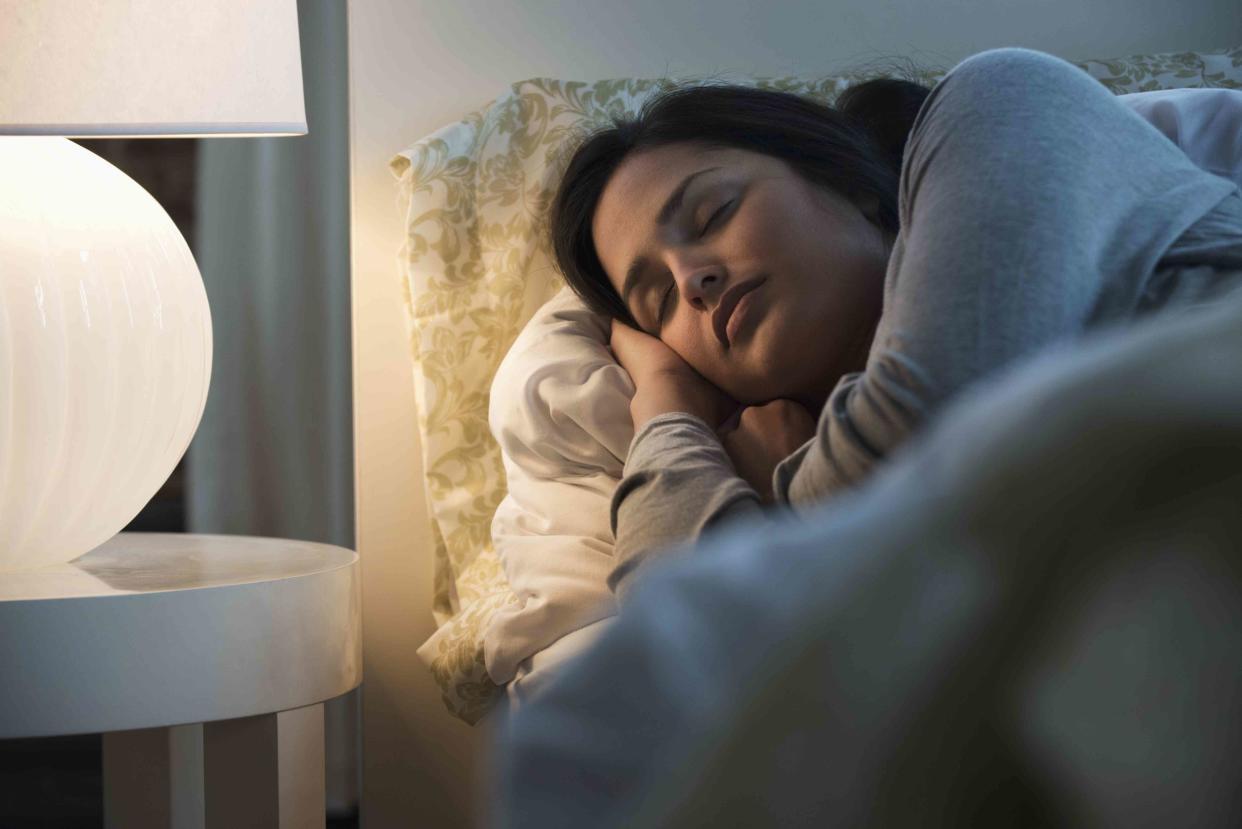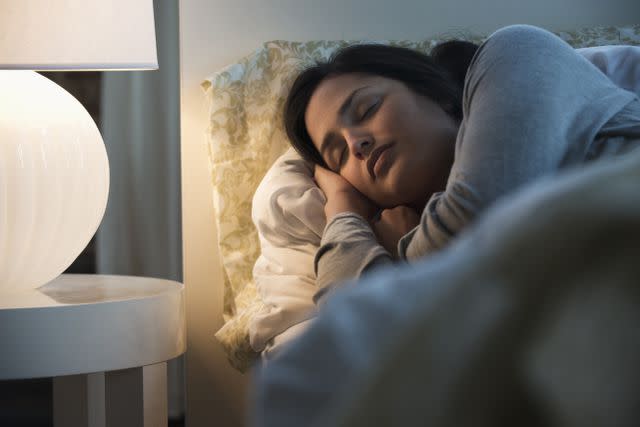The Ultimate Guide to Sleep Sounds: Pink Noise, Brown Noise, and White Noise, Explained

Getty Images / Jose Luis Pelaez Inc
Sleep sounds—the frequency of vibrations that occur per second—are growing in popularity in the wellness space.
Colors are used to identify the decibel associated with certain sounds. There is white, pink, brown, blue, violet, and gray sleep sounds.
Experts note that while more research is still needed to determine sleep sounds' effectiveness, individuals should choose continuous (instead of scattered patterns) noise if they do choose to use a sleep sound.
Sleep sounds are growing in popularity within the wellness space, and for good reason—sleep is a necessity for overall well-being.
How to get the best shuteye is continuously up for debate, from the right number of hours and type of sleep to the best environment conducive to sleep. But sleep sounds—that is, the frequency of vibrations that occur per second—are less familiar to the general public. Sure, not using your phone right before bed is common sense, but what difference do the frequency of vibrations around you matter to your sleep?
The short answer? It actually makes a huge difference.

Getty Images / Jose Luis Pelaez Inc
Breaking Down Sleep Noises
Raj Bhui, MD, family medicine specialist and spokesperson for the American Academy of Sleep Medicine (AASM), explained that in broad strokes, frequency is the number of vibrations (e.g., a singer’s vocal cords) or cycles occurring per second. The 20–20,000 Hz (vibrations per second) range of frequencies is typically audible to the human ear.
“A soprano produces a high frequency and a baritone a low frequency,” he told Health. “The colors differ in how they distribute intensity at each frequency.”
Dr. Bhui explains each color like this:
White noise contains all of these frequencies at equal intensities. Think static that comes from a radio or television.
Pink noise contains the same range of frequencies, but the intensity decreases as frequency increases (by 3 decibels per octave). This has the result of emphasizing lower pitches and sounding ‘softer’ or ‘less harsh’ than white noise. The sound of wind or a waterfall is
similar to pink noise.Brown noise (also called red noise) is similar to pink noise, except that the intensity decays more rapidly as frequency increases (6 decibels per octave), giving it a more rumbling character. People report brown noise to the liking of rain or running water in a shower.
Blue noise mirrors pink noise in the size of steps (3 decibels per octave), except intensity increases with frequency.
Violet noise is similar to blue noise as it has intensity increasing with frequency, though mirroring the step size of brown/red noise (6 decibels per octave). This makes the higher frequencies more prominent.
Grey noise has a low intensity in the middle frequencies and increases intensity at both ends of the audible acoustic spectrum, yielding a U-shaped curve.
What the Science Says
Dr. Bhui explained there is some low-quality data suggesting that different sounds or music may help with relaxation, concentration, or sleep in different groups. However, overall, he said more evidence-based research is needed to validate the benefits of sleep noise as a sleep aid.
Most of the research that’s been done has been conducted on white noise. Generally speaking, the consensus is that white noise may be helpful in environments where loud noises are likely to occur, like a city, but the addition of white noise provides the opportunity for disrupted sleep for some individuals.
While it’s true that white noise could help mask noises if you live somewhere noisier, Elizabeth Devon Smith, PhD, a psychologist in the division of pulmonary, critical care, and sleep medicine at National Jewish Health, told Health. “Keep in mind that masking noises may have downsides if you actually do need to hear those noises,” she said.
Aside from a potential sleep aid, research shows that white noise could aid with symptoms of attention deficit hyperactivity disorder (ADHD) in children.
“Medically, white noise may provide some relief to people with distressing symptoms associated with conditions like tinnitus, associated with ‘ringing in the ears,’ or hyperacusis, involving increased sensitivity to ordinary environmental sounds,” explained Dr. Bhui.
Dr. Smith added that one of the theories for why white noise may improve sleep is that it serves to mask other sounds that could disrupt sleep, as hearing doesn’t necessarily “turn off” during sleep.
“Another theory is that these sleep sounds may become a cue for sleep with repeated use, which essentially means we can train ourselves to associate white noise with sleep,” she said.
Related:Sleeping With a CPAP Machine for Sleep Apnea
What to Consider Before Using Sleep Sounds
Dr. Bhui cautions people against considering sleep sounds a “natural” solution to sleep, as they are generally provided through electronic devices.
“However, it might be thought of as a non-invasive, non-pharmacological intervention that is generally low risk for causing harm if used appropriately,” he said.
Before adding sleep sounds to an evening routine, individuals should have realistic expectations for the practice. Dr. Smith emphasized the importance of acknowledging that sleep noise is not a cure-all solution.
Once you’ve decided that additional sleep noise may be an appropriate choice for you, protecting your ears is a top priority, Dr. Bhui said.
“There are many people who struggle with tinnitus and hearing loss after brief or long-term exposure to loud noises. Additionally, hearing loss is associated with increased risk of psychiatric and neurological disorders, such as depression, anxiety disorders, dementia, and even psychoses,” he said.
Monitoring the decibels (dB) your ears are exposed to will help you ensure you're staying safe. In general, prolonged exposure to noise above 70–80 dB may increase the risk of hearing loss, with the speed of hearing loss rapidly increasing with intensity, Dr. Bhui clarified.
In addition to keeping the noise down, Dr. Smith recommended choosing continuous noise.
“Some research has suggested that changes in sound (like a song changing or a commercial coming on a podcast) can disrupt our sleep stages, even if we don’t fully wake up, resulting in poorer quality sleep,” she said.
Another option could be to use a sleep timer, especially if the goal is to help during the period of sleep initiation at the beginning of the night.
Options abound for noise machines that offer sleep noise and timers.
If you’re looking for an option that you don’t have to pay for, there are many apps that offer sleep noise: BetterSleep, Headspace, myNoise, and White Noise Deep Sleep Sounds, and White Noise Lite are all options to explore.
You can also play certain calming sounds on Apple iPhones with the newest iOS 16 update, by going to "Settings," selecting "Accessibility," then "Audio/Visual," and "Background Sounds."
When to Get Help From a Sleep Specialist
As a clinical psychologist, Dr. Smith works with people who have a history of trouble falling or staying asleep and have tried sleep hygiene tips and tricks, such as controlling sound, lighting, temperature, and more.
“They are sometimes frustrated that these changes have not worked for them. However, research shows that, unfortunately, sleep hygiene alone is not an effective treatment for insomnia,” she said.
She recommends cognitive behavioral therapy for insomnia (CBT-I) for those who need more help.
“[It] involves much more than just changes to the sleep environment. That being said, sleep hygiene, including noise control, does have a place in general sleep health.”
Related:12 Signs of Sleep Deprivation You Need to Know
For more Health news, make sure to sign up for our newsletter!
Read the original article on Health.

